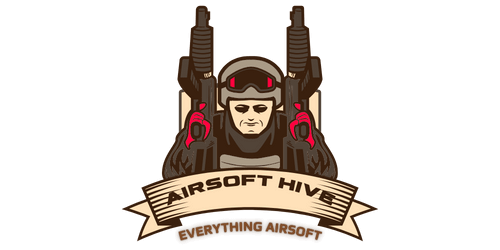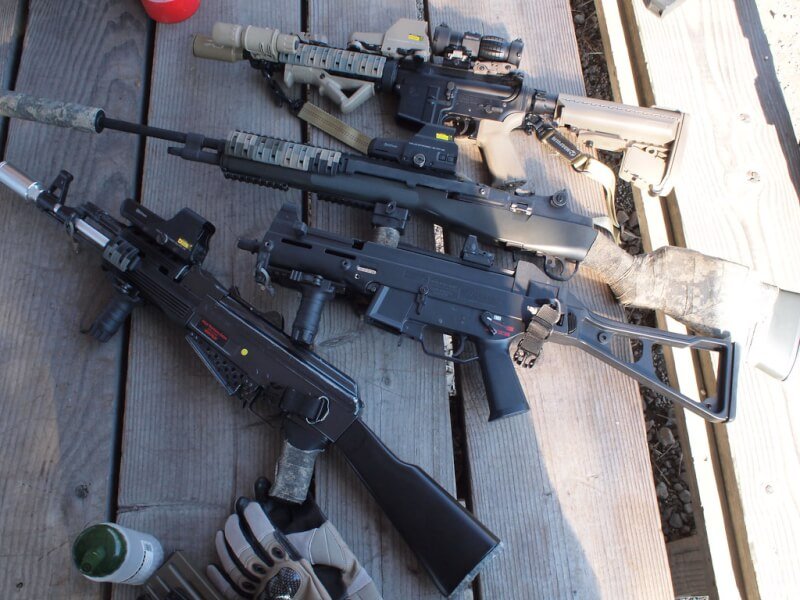So you’re in the market for an airsoft gun, but you’re concerned about the possibility of stumbling upon a counterfeit. Whether you’re a seasoned enthusiast or a beginner looking to join the exciting world of airsoft battles, it’s crucial to distinguish between the genuine article and a knockoff. In this article, you will discover a few simple yet effective tips that will empower you to spot a counterfeit airsoft gun with confidence. Protect yourself from disappointment and make an informed purchasing decision by keeping an eye out for these telltale signs.
Checking the Packaging
When attempting to identify a counterfeit airsoft gun, one of the first steps is to carefully examine the packaging. The packaging can provide valuable clues about the authenticity of the product.
Examining the Box
Start by thoroughly examining the box in which the airsoft gun is packaged. Look for any signs of poor quality, such as flimsy cardboard or inconsistent printing. Authentic airsoft gun manufacturers take pride in their products and usually invest in high-quality packaging to reflect this.
Analyzing the Labels
Next, focus on the labels affixed to the box. Authentic airsoft guns often have labels that are clear, well-printed, and properly aligned. Counterfeit products may have labels that are blurry, misaligned, or contain typographical errors. Take a closer look at the logos and trademarks displayed on the labels – they should be crisp and accurate representations of the brand.
Assessing the Quality of Packaging Materials
Counterfeit airsoft guns are often packaged with subpar materials. Inspect the foam padding inside the box to ensure it is of decent quality and provides proper protection for the gun. Additionally, check if the packaging includes any official documentation, such as user manuals or warranty cards. Authentic airsoft guns generally come with these materials, while counterfeit versions may lack them or have poorly printed copies.
Examining the Gun’s Appearance
Once you have thoroughly assessed the packaging, it’s time to focus on the airsoft gun itself. The gun’s appearance can reveal a great deal about its authenticity.
Comparing with Authentic Models
If possible, compare the airsoft gun with legitimate models of the same make and model. Analyze the overall shape, size, and details. Counterfeit guns often have slight variations or inaccuracies compared to the genuine ones, such as different angles or proportions. Pay attention to these discrepancies as they can be valuable indicators of a counterfeit.
Looking for Imperfections
Inspect the airsoft gun for any imperfections that may suggest it is a counterfeit. Counterfeit products are often produced hastily and with less attention to detail, resulting in visible flaws. Look for signs of poor paint quality, rough edges, inconsistent coloring, or rough seams. Authentic airsoft guns will generally have a higher level of craftsmanship.
Verifying Logos and Trademarks
Carefully check the logos and trademarks on the airsoft gun. Authentic guns will typically have well-defined and accurate markings, while counterfeit versions may have blurry or poorly executed logos. Take note of any inconsistencies, misspellings, or altered branding elements, as these are clear indications of a potential counterfeit.
Assessing the Build Quality
The build quality of an airsoft gun is a crucial factor in determining its authenticity. It involves evaluating the materials used and inspecting the fit and finish.
Examining the Materials Used
Authentic airsoft guns are typically made with high-quality materials that contribute to their durability and performance. Counterfeit guns, on the other hand, often employ lower quality materials that may feel flimsy or cheap. Take note of the materials used in the construction of the gun, such as metal, polymer, or other components, and compare them to known authentic models.
Inspecting the Fit and Finish
When examining the airsoft gun, pay close attention to how it is assembled and finished. Counterfeit guns may have loose or poorly fitting parts, such as wobbly stocks or loose handguards. Authentic airsoft guns usually have precise fitment and solid construction. Check for any gaps, misalignments, or other signs of poor assembly. A properly built gun is more likely to be authentic.
Checking for Loose Parts
Another aspect of assessing the build quality is checking for any loose or rattling parts. Counterfeit airsoft guns may have parts that are not securely attached or improperly aligned, leading to potential performance issues. Confirm that all buttons, switches, and components are firmly in place. A genuine airsoft gun should feel solid and well-constructed.
Evaluating the Weight and Balance
The weight and balance of an airsoft gun can provide important insights into its authenticity and overall quality.
Comparing with Authorized Models
If possible, compare the weight and balance of the airsoft gun in question with that of authorized models. Counterfeit guns may have variations in weight distribution or feel noticeably lighter than their genuine counterparts. Take note of any discrepancies and evaluate whether they align with what is expected from the specific make and model.
Verifying Distribution of Weight
Authentic airsoft guns are typically designed to have a balanced weight distribution, allowing for better control and accuracy during use. Counterfeit guns may have uneven weight distribution, resulting in a less stable shooting experience. Hold the gun in different positions and assess how it feels in terms of weight and balance. A genuine airsoft gun should feel comfortable and well-balanced in your hands.
Assessing Durability and Sturdiness
While evaluating weight and balance, also consider the overall durability and sturdiness of the airsoft gun. Counterfeit guns may feel flimsy or fragile due to the use of inferior materials or subpar construction. Pay attention to any unexpected flexing or creaking of the gun when handling it. Authentic airsoft guns are engineered to withstand regular use and should feel solid and robust.

Inspecting the Markings and Engravings
Markings and engravings on an airsoft gun can provide important clues about its authenticity and manufacturing quality.
Examining Serial Numbers
Authorized airsoft guns often have unique serial numbers engraved or stamped onto the gun. These serial numbers can be cross-referenced with the manufacturer’s records to confirm authenticity. Carefully examine the serial number on the gun and look for any signs of tampering or inconsistencies. Counterfeit guns may have poorly engraved or duplicated serial numbers, indicating the potential for a fake.
Checking for Legible Markings
Authentic airsoft guns typically have clear and legible markings, such as the manufacturer’s name, model number, and country of origin. Counterfeit guns may have markings that are blurry, uneven, or difficult to read. Ensure that all markings are well-defined and easily distinguishable. A genuine airsoft gun will have precise and consistently engraved or printed markings.
Analyzing Depth and Quality of Engravings
Counterfeit airsoft guns often skimp on the quality of engravings, resulting in shallow or poorly executed marks. Carefully analyze the depth and quality of the engravings on the gun. Authentic airsoft guns will have sharp, deep, and well-defined engravings, while counterfeit versions may appear superficial or lack clarity. Deep, precise engravings are a strong indicator of an authentic airsoft gun.
Verifying the Functionality
To determine the authenticity of an airsoft gun, it is essential to test its functionality and performance.
Checking the Safety Features
A reliable airsoft gun should have functional safety features that allow for safe handling and operation. Test the safety switch to confirm that it operates smoothly and effectively. Additionally, check for any other safety mechanisms relevant to the specific model, such as magazine disconnects or blowback systems. Counterfeit guns may lack proper safety features or have non-functional ones.
Evaluating the Trigger Response
Pull the trigger of the airsoft gun to assess its response. Authentic guns typically have triggers that are smooth, consistent, and responsive. Counterfeit guns may have triggers that feel sticky, rough, or uneven when pulled. Take note of any abnormalities in the trigger’s feel and response, as this can indicate a potential counterfeit.
Assessing the Magazine Release Mechanism
If the airsoft gun has a detachable magazine, evaluate the magazine release mechanism. Check if the magazine slides in and out smoothly and securely. Counterfeit guns may have magazines that do not fit properly or release inadequately. Authentic airsoft guns will generally have well-designed and reliable magazine release mechanisms.
Examining the Inner Mechanisms
To gain further insights into the authenticity and quality of an airsoft gun, it is necessary to examine its internal components.
Disassembling the Gun
If you are knowledgeable and comfortable with airsoft gun disassembly, carefully take apart the gun to access its internal mechanisms. Counterfeit guns may have substandard or poorly constructed internals, which can affect their performance and longevity. Pay close attention to the quality of materials used, such as gears, springs, and the gearbox.
Verifying Quality of Internals
When inspecting the internals of the airsoft gun, evaluate the quality and precision of the components. Authentic airsoft guns are typically built with high-quality internals, resulting in better performance and reliability. Counterfeit guns may have cheap, inferior components that are more prone to breakage or malfunction. Look for signs of wear, damage, or poor craftsmanship.
Assessing the Gearbox and Hop-up
The gearbox and hop-up are critical components of an airsoft gun’s performance. Carefully examine the gearbox for any signs of wear, damage, or poor assembly. Check the hop-up unit for proper alignment and functionality. Counterfeit guns may have poorly constructed or ineffective gearbox and hop-up units. Authentic airsoft guns should have well-crafted and high-performing internals.
Checking the Performance
To ensure you are investing in an authentic and reliable airsoft gun, it is crucial to assess its performance capabilities.
Testing the FPS (Feet Per Second)
FPS, or Feet Per Second, refers to the speed at which the airsoft gun fires BBs. Use a chronograph to measure the FPS of the gun during test firing. Compare the recorded FPS with the manufacturer’s specifications for the specific model. Significant deviations may indicate a counterfeit or potentially modified gun. Additionally, check for consistent FPS readings across multiple shots.
Evaluating Accuracy and Range
Test the accuracy and range of the airsoft gun by firing it at a target under controlled conditions. Observe how consistently the BBs hit the target at various distances. Authentic airsoft guns are designed to offer good accuracy and consistent performance. Counterfeit guns may have poor accuracy, inconsistent trajectories, or limited range. Assess the gun’s ability to hit the target accurately and consistently.
Assessing the Consistency of Shots
Consistency is a vital aspect of an airsoft gun’s performance. Fire multiple shots in succession and observe whether the BBs consistently travel in a straight line with minimal deviation. Counterfeit guns may exhibit erratic or unreliable shot patterns, resulting in inconsistent performance. A genuine airsoft gun should provide consistent and reliable shot placement.
Researching Authorized Sellers
To increase your chances of purchasing an authentic airsoft gun, it is advisable to research and verify the reputation of the seller.
Verifying the Seller’s Reputation
Before making a purchase, research the seller or retailer from whom you plan to buy the airsoft gun. Look for customer reviews, ratings, and feedback to gauge the seller’s reputation. Trusted and authorized sellers are more likely to provide genuine products. Be cautious of sellers with a history of selling counterfeit or low-quality items.
Checking for Official Certifications
Authentic airsoft gun manufacturers often have official certifications or partnerships with authorized sellers. Check if the seller has any official certifications or has been authorized by the manufacturer. This information can usually be found on the manufacturer’s website or through reliable online sources. Buying from certified sellers reduces the risk of purchasing a counterfeit airsoft gun.
Analysing Customer Reviews
Reading customer reviews can provide valuable insights into the authenticity and reliability of the airsoft gun and seller. Look for reviews specifically mentioning the authenticity of the product or any issues faced by customers with counterfeit guns. Genuine customer reviews can give you a better understanding of the seller’s reputation and the quality of the products they offer.
Getting Professional Verification
If you are uncertain about the authenticity of an airsoft gun, it is advisable to seek professional verification from experts or authorized retailers.
Seeking Assistance from Experts
Reach out to knowledgeable individuals who have experience with airsoft guns, such as experienced players, experts, or verified airsoft specialists. They can provide guidance and help you assess the authenticity of the gun based on their expertise. Sharing detailed pictures and information with experts can assist in making an informed decision.
Contacting Authorized Airsoft Retailers
Contact authorized airsoft retailers or manufacturers directly to verify the authenticity of the gun you are considering purchasing. Provide them with the necessary details, such as serial numbers, photographs, and any other relevant information. Authorized retailers will have access to databases and can provide accurate information regarding the legitimacy of the gun.
Engaging Professional Airsoft Communities
Joining professional airsoft communities and forums can provide valuable insights and advice from experienced players and enthusiasts. Engage in discussions, seek recommendations, and share your concerns about potential counterfeit airsoft guns. Professional communities can offer support, knowledge, and connections to help you in your quest for an authentic airsoft gun.
In conclusion, spotting a counterfeit airsoft gun requires careful inspection and evaluation of various aspects, including the packaging, appearance, build quality, weight and balance, markings and engravings, functionality, internal mechanisms, performance, seller reputation, and seeking professional verification. By thoroughly examining these factors, you can greatly increase your chances of purchasing an authentic and reliable airsoft gun. Remember to prioritize safety and always purchase from trusted and authorized sellers to ensure a positive airsoft experience.


